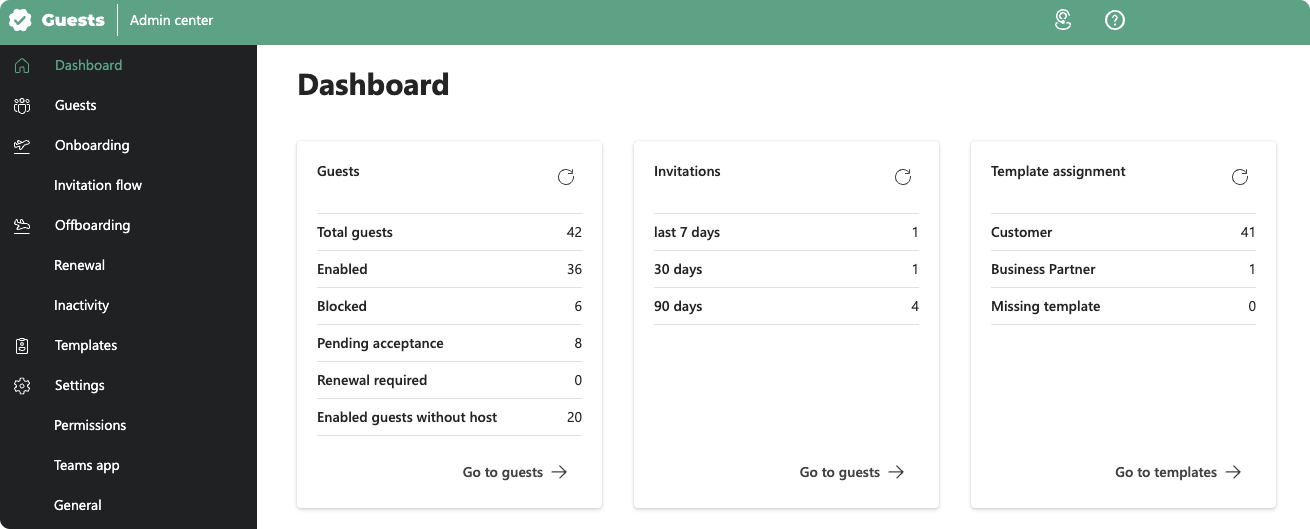Easily gain overview of guests in your Microsoft 365 tenant
In today’s digital age, businesses rely heavily on collaboration and data sharing. With the rise of remote work and the need for efficient communication, organizations often invite external partners, clients, or vendors into their Microsoft 365 or Entra ID tenant as guests. While this facilitates collaboration, it also introduces complexities in managing guest accounts and ensuring the security of sensitive company data.
In this blog post, we will discuss the importance of maintaining an overview of guest accounts in your tenant, and why it is crucial to have a clear picture of their status, permissions, and responsible persons within your organization. We will also delve into the significance of seeing the total number of active guests, their types, and other key metrics in one concise page.
Why overview matters
Maintaining an overview of guest accounts is not just an administrative task; it is a critical element of your organization’s security strategy. Here’s why it matters:
1. Avoiding wrong sharing
When you have numerous guests with access to your company data, it becomes increasingly challenging to ensure that the right people have the right permissions. Without proper oversight, there is a higher risk of sensitive information being shared with unintended recipients, potentially leading to data breaches or confidentiality breaches.
2. Preventing unwanted guest access
Unauthorized access to your organization’s resources can have detrimental consequences. Keeping a close watch on guest accounts allows you to identify and promptly block or revoke access for any accounts that pose a security threat. This is particularly vital in preventing account hijacking or unauthorized use of company resources.
3. Accountability
Knowing who is responsible for each guest account in your organization ensures that you have a designated point of contact for any issues or concerns related to these accounts. This accountability streamlines communication and problem resolution.
What to look for
To maintain a comprehensive overview of guest accounts, you should be able to see the following information at a glance:
-
Total number of active guests: Quickly determine the total number of guest accounts in your tenant.
-
Enabled, blocked, or inactive: Differentiate between active, blocked, and inactive guest accounts to ensure the right level of access control.
-
Unredeemed invitations: Identify accounts where the invitation to become a guest has not been redeemed, potentially indicating a need for follow-up.
-
Renewal status: Keep track of guest accounts that require renewal or review to ensure their continued relevance.
-
Inactivity monitoring: Identify guests with long periods of inactivity, as these accounts may need special attention or deactivation.
-
Recent invitations: Get a sense of the influx of new guests by monitoring how many have been invited recently.
-
Types of guest accounts: Understand the diversity of guest account types in your tenant, such as external partners, clients, vendors, or specific project collaborators.
The power of a unified overview
Having all this information accessible in one consolidated report is paramount for administrators. Therefore, the dashboard in the Guests Admin Center provides an overview of the guest status at a glance. It provides a real-time gut feeling about the guest account landscape within your organization, which can inform security decisions and resource allocation. It streamlines the process of identifying and addressing potential issues before they escalate.

In conclusion, gaining an overview of guest accounts in your Microsoft 365 or Entra ID tenant is not just a matter of convenience; it’s a fundamental aspect of data security and efficient collaboration. By monitoring guest account status, permissions, and relevant metrics, organizations can maintain control, accountability, and peace of mind in today’s collaborative digital environment.
Stay vigilant, and keep a watchful eye on your guest accounts to safeguard your organization’s sensitive data and foster secure collaboration.
Keep track of your guests!
If we have piqued your interest, simply start a free Guests trial and gain a comprehensive overview of your guests in just a few moments. All you need is a Microsoft 365 administrator account with the appropriate permissions. You can access the free trial here.
Ready to dive in?
No credit card required